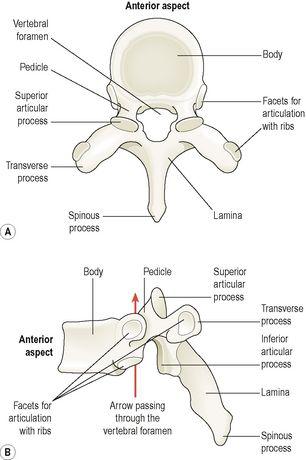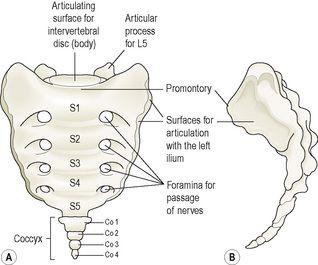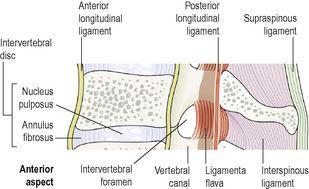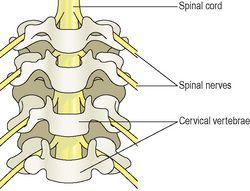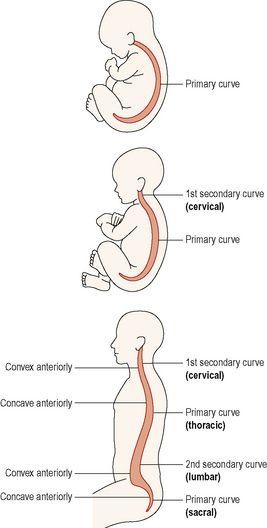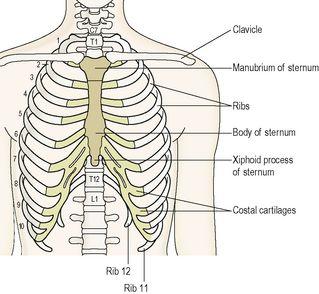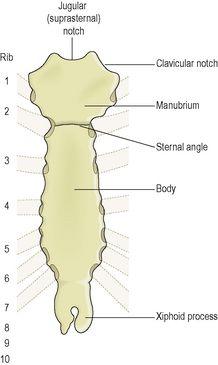Ross & Wilson Anatomy and Physiology in Health and Illness (183 page)
Read Ross & Wilson Anatomy and Physiology in Health and Illness Online
Authors: Anne Waugh,Allison Grant
Tags: #Medical, #Nursing, #General, #Anatomy

The 7th cervical vertebra, C7, is also known as the
vertebra prominens
. It possesses a long spinous prominence terminating in a swollen tubercle, which is easily felt at the base of the neck.
Thoracic vertebrae (
Fig. 16.23
)
The twelve thoracic vertebrae are larger than the cervical vertebrae because this section of the vertebral column has to support more body weight. The bodies and transverse processes have facets for articulation with the ribs.
Figure 16.23
A thoracic vertebra. A.
Viewed from above.
B.
Viewed from the side.
Lumbar vertebrae (
Fig. 16.20
)
These are the largest of the vertebrae because they have to support the weight of the upper body. They have substantial spinous processes for attachment of the muscles of the lower back.
Sacrum (
Fig. 16.24
)
This consists of five rudimentary vertebrae fused to form a triangular or wedge-shaped bone with a concave anterior surface. The upper part, or base, articulates with the 5th lumbar vertebra. On each side it articulates with the ilium to form a
sacroiliac joint
, and at its inferior tip it articulates with the coccyx. The anterior edge of the base, the
promontory
, protrudes into the pelvic cavity. The vertebral foramina are present, and on each side of the bone there is a series of foramina for the passage of nerves.
Figure 16.24
The sacrum and coccyx. A.
Anterior view.
B.
Lateral view.
Coccyx (
Fig. 16.24
)
This consists of the four terminal vertebrae fused to form a very small triangular bone, the broad base of which articulates with the tip of the sacrum.
Features of the vertebral column
Intervertebral discs
The bodies of adjacent vertebrae are separated by
intervertebral discs
, consisting of an outer rim of fibrocartilage (
annulus fibrosus
) and a central core of soft gelatinous material (
nucleus pulposus
) (
Fig. 16.25
). They are thinnest in the cervical region and become progressively thicker towards the lumbar region, as spinal loading increases. The posterior longitudinal ligament in the vertebral canal helps to keep them in place. They have a shock-absorbing function and the cartilaginous joints they form contribute to the flexibility of the vertebral column as a whole.
Figure 16.25
Section of the vertebral column showing the ligaments, intervertebral discs and intervertebral foramina.
Intervertebral foramina
When two adjacent vertebrae are viewed from the side, a foramen formed by a gap between the vertebral pedicles can be seen. Half of the wall is formed by the vertebra above, and half by the one below (
Fig. 16.26
).
Figure 16.26
Lower cervical vertebrae separated to show the spinal cord and spinal nerves emerging through the intervertebral foramina.
Anterior view.
Throughout the length of the column there is an intervertebral foramen on each side between every pair of vertebrae, through which the spinal nerves, blood vessels and lymph vessels pass.
Ligaments of the vertebral column (
Fig. 16.25
)
These ligaments hold the vertebrae together and keep the intervertebral discs in position.
The
transverse ligament
maintains the odontoid process of the axis in the correct position in relation to the atlas (
Fig. 16.22C
).
The
anterior longitudinal ligament
extends the whole length of the column and lies in front of the vertebral bodies.
The
posterior longitudinal ligament
lies inside the vertebral canal and extends the whole length of the vertebral column in close contact with the posterior surface of the bodies of the bones.
The
ligamenta flava
connect the laminae of adjacent vertebrae.
The
ligamentum nuchae
and the
supraspinous ligament
connect the spinous processes, extending from the occiput to the sacrum.
Curves of the vertebral column (
Fig. 16.27
)
When viewed from the side, the vertebral column presents four curves: two
primary
and two
secondary
.
Figure 16.27
Development of the spinal curves.
The fetus in the uterus lies curled up so that the head and the knees are more or less touching. This position shows the
primary curvature
. The secondary
cervical curve
develops when the child can hold up his head (after about 3 months) and the secondary
lumbar curve
develops when he stands upright (after 12 to 15 months). The thoracic and sacral primary curves are retained.
Movements of the vertebral column
The movements between the individual bones of the vertebral column are very limited. However, the movements of the column as a whole are quite extensive and include
flexion
(bending forward),
extension
(bending backward),
lateral flexion
(bending to the side) and
rotation
. There is more movement in the cervical and lumbar regions than elsewhere.
Functions of the vertebral column
These include the following.
•
Collectively the vertebral foramina form the vertebral canal, which provides a strong bony protection for the delicate spinal cord lying within it.
•
The pedicles of adjacent vertebrae form intervertebral foramina, one on each side, providing access to the spinal cord for spinal nerves, blood vessels and lymph vessels.
•
The numerous individual bones with their intervertebral discs allow movement of the whole column.
•
It supports the skull.
•
The intervertebral discs act as shock absorbers, protecting the brain.
•
It forms the axis of the trunk, giving attachment to the ribs, shoulder girdle and upper limbs, and the pelvic girdle and lower limbs.
Thoracic cage (
Fig. 16.28
)
The thorax (thoracic cage) is formed by the sternum anteriorly, twelve pairs of ribs forming the lateral bony cages, and the twelve thoracic vertebrae.
Figure 16.28
The thoracic cage.
Anterior view.
Sternum (breast bone) (
Fig. 16.29
)
This flat bone can be felt just under the skin in the middle of the front of the chest.
